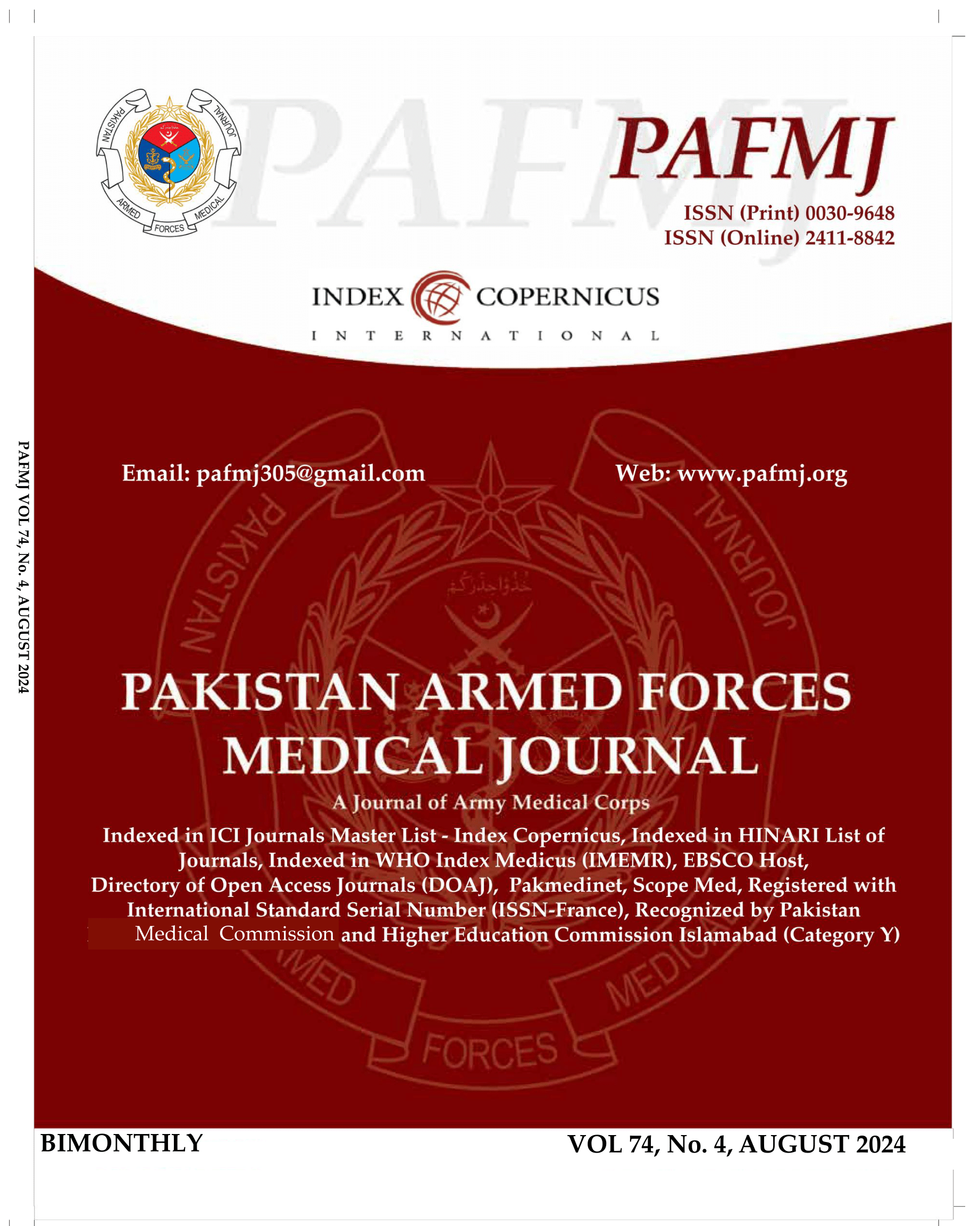Tongue Lesions in Pakistani population, Subjective Awareness and Association with Blood Groups
DOI:
https://doi.org/10.51253/pafmj.v74i4.11741Keywords:
ABO blood groups, coated tongue, tongue lesions.Abstract
Objective: To determine the frequency of various tongue lesions diagnosed during dental examination in a Pakistani population and to assess their association with blood groups.
Study Design: Cross-sectional study.
Place and Duration of the Study: Outpatient Department, Dental College Hospital of Heavy Industries Taxila Educational City Institute of Medical Sciences and Dental OPD, Heavy Industries Taxila Hospital, Taxila Pakistan, from Oct 2022 to Sep 2023.
Methodology: The study included five hundred patients. It excluded pregnant women and participants with a diagnosed malignant condition. Those who gave consent were examined for the absence or presence of tongue lesions like Aphthous ulcer, Fissured tongue, coated tongue, geographic tongue and median rhomboid glossitis on the basis history and clinical presentation.
Results: The study included five hundred patients. It was discovered that 19(3.80%) of the participants had aphthous ulcers, 17(3.40%) of the participants had fissured tongues, 24(4.80%) had geographic tongue, 146(29.20%) had coated tongue, and 19(3.80) had median rhomboid glossitis. Aphthous ulcers were more common in the O+ blood group, the A+ blood group had more cases of Fissure tongue, the O+ blood group had more cases of Coated tongue, and the O- blood group had more cases of Geographic tongue.
Conclusion: Different tongue lesions had varying frequency in our population, with coated tongue being the most prevalent. However, there were no statistically significant differences in the distribution of tongue lesions among various blood groups.
Downloads
References
Plaza E, Busanello-Stella AR. Tongue strength and clinical correlations in Parkinson’s disease. J Oral Rehabil 2023; 50(4): 300–307. https://doi.org/10.1111/joor.13417
Shamim MZM, Syed S, Shiblee M, Usman M, Ali SJ, Hussein HS, et al. Automated Detection of Oral Pre-Cancerous Tongue Lesions Using Deep Learning for Early Diagnosis of Oral Cavity Cancer. Comput J 2022; 65(1): 91–104.
https://doi.org/10.1093/comjnl/bxaa136
Lombardi N, Moneghini L, Varoni EM, Lodi G. Nodular migratory tongue lesions: Atypical geographic tongue or a new entity? Oral Dis. 2023; 29(4): 1791–1794.
https://doi.org/10.1111/odi.14158
Mangold AR, Torgerson RR, Rogers RS. Diseases of the tongue. Clin Dermatol 2016; 34(4): 458–469.
https://doi.org/10.1016/j.clindermatol.2016
Groot HE, Villegas Sierra LE, Said MA, Lipsic E, Karper JC, Van Der Harst P. Genetically Determined ABO Blood Group and its Associations With Health and Disease. Arterioscler Thromb Vasc Biol 2020; 40(3): 830–838.
https://doi.org/10.1161/ATVBAHA.119.313658
Pal A. Assessment of Relationship of ABO-RH Blood Group in Oral Cancer Patients: A Prospective Cohort Study of Hospital Patients.
https://doi.org/10.4103%2Fams.ams_265_20
Abegaz SB. Human ABO Blood Groups and Their Associations with Different Diseases. Biomed Res Int 2021; 2021.
https://doi.org/10.1155/2021/6629060
Kalantari M, Hashemipour MA, Hasani N, Salehi I. Prevalence of tongue lesions in a population of Iranian schoolchildren in 2020. J Oral Heal Oral Epidemiol 2023; 12(2): 71–76.
https://doi.org/10.34172/johoe.2023.12
Kaustubh JD, Vineet V, Madhukar WM, Amita A. Study Strategies of Dental Students and its Relation to Academic Performance. Vol. 10, Indian Journal of Dental Education. 2017; 10: 201–205. https://doi.org/10.21088/ijde.0974.6099.10417.1
Ewald DR, Sumner SCJ. Blood type biochemistry and human disease. Wiley Interdiscip Rev Syst Biol Med 2016; 8(6): 517–535.
https://doi.org/10.1002/wsbm.1355
Kitamura N, Sento S, Yoshizawa Y, Sasabe E, Yamamoto T. Tongue necrosis caused by systemic vascular diseases: A systematic review of the literature. Oral Sci Int 2020; 17(2): 51–58.
https://doi.org/10.1002/osi2.1054
Goyal R, Goyal MK. Influence of Life Style Factors on Oral Potentially Malignant and Malignant Disorders: A Cross Sectional Study. Indian J Otolaryngol Head Neck Surg 2021; 73(4): 443–446. https://doi.org/10.1007/s12070-020-02084-5
Patil S, Doni B, Maheshwari S. Prevalence and distribution of oral mucosal lesions in a geriatric Indian Population. Can Geriatr J 2015; 18(1): 11–114. https://doi.org/10.5770/cgj.18.123
Li Y, Cui J, Liu Y, Chen K, Huang L, Liu Y. Oral, Tongue-Coating Microbiota, and Metabolic Disorders: A Novel Area of Interactive Research. Front Cardiovasc Med 2021; 8(August): 1–9. https://doi.org/10.3389/fcvm.2021.730203
Chakrani Z, Robinson K, Taye B. Association Between ABO
Blood Groups and Helicobacter pylori Infection: A Meta-Analysis. Sci Rep 2018; 8(1): 11.
http://doi.org/10.1038/s41598-018-36006-x
Fan Q, Zhang W, Li B, Li DJ, Zhang J, Zhao F. Association Between ABO Blood Group System and COVID-19 Susceptibility in Wuhan. Front Cell Infect Microbiol 2020; 10(July): 7.
https://doi.org/10.3389/fcimb.2020.00404
Al Qahtani NA, Deepthi A, Alhussain NM, Al Shahrani BAM, Alshehri H, Alhefzi A, et al. Association of geographic tongue and fissured tongue with ABO blood group among adult psoriasis patients: a novel study from a tertiary care hospital in Saudi Arabia. Oral Surg Oral Med Oral Pathol Oral Radiol 2019; 127(6): 490–497. https://doi.org/10.1016/j.oooo.2019.01.080
Sagiroglu S, Oztarakci H, Ozturk P, Doganer A, Koca T, Bilal N, et al. The association of ABO blood group and rh factor with recurrent aphthous ulceration. Ann Med Res 2018; 25(4): 540.
Downloads
Published
Issue
Section
License
Copyright (c) 2024 Ambreen Gul, Naila Zakria, Rabbia Shabbir, Raheela Yasmin, Muhammad Naufal Nadeem, Faiqa Hassan

This work is licensed under a Creative Commons Attribution-NonCommercial 4.0 International License.















